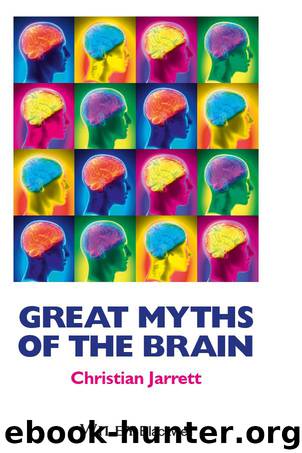Great Myths of the Brain by Jarrett Christian

Author:Jarrett, Christian
Language: eng
Format: epub
ISBN: 9781118312704
Publisher: Wiley
Published: 2014-11-03T00:00:00+00:00
Bodily Effects on Thoughts and Morality
Those last two studies involving marbles and upward movements come from an emerging field in psychology known as “embodied cognition,” (also sometimes referred to as “grounded cognition”) in which researchers are exploring the links between bodily sensations and the way we think and perceive. In one line of this research, psychologists have shown that physical sensations like warmth can affect our judgments about other people. Lawrence Williams and John Bargh found that participants who'd held a cup of hot coffee subsequently judged a stranger in more “warm terms,” for example, describing him as good-natured and generous, as compared with other participants who described the stranger after holding an iced-coffee.77
Although some findings in this field have proven tricky to replicate, many experts think the underlying mechanism is real – that is, the physical metaphors we use in our language reflect the way we represent abstract concepts such as “goodness” in bodily terms like “warmth.” Another relevant finding here, provided by Hans Ijzerman and Gun Semin, was that participants felt socially closer to an experimenter when they were tested in a warm room as opposed to a cool room.78 The room's temperature even affected the way these participants perceived simple shapes shown on a screen. Participants in a warm room showed a bias toward focusing on how the shapes were arranged in relation to each other; those in a cooler room focused more on the form taken by the individual shapes.
Yet another line of this research highlights the way our eye movements affect our numerical thinking. In 2010, a team led by Tobias Loetscher at the University of Melbourne asked participants to produce a string of random numbers.79 The researchers found that they could predict the relative magnitude of the next number a participant produced based on the direction of their eye movements. A glance upwards or rightwards tended to precede a larger number while a downward or leftward glance preceded smaller numbers. The finding is consistent with the idea that we think about numbers as being placed along a mental number line. “A close look at the eyes may not only reveal what is in a person's mind,” the researchers concluded, “but also illustrate how abstract thoughts are grounded in basic sensory-motor processes.”
Support for this interpretation came from a fun study by Anita Eerland and her colleagues published in 2011.80 They had participants stand on a Wii balance board and make various judgments of magnitude such as the number of hits Michael Jackson had had in the Netherlands or the height of the Eiffel Tower. When the researchers used the Wii board to cause the participants to lean to the left slightly (without them knowing), the participants tended to make smaller estimates. For example, left-leaning participants estimated the Tower was 12 meters shorter, on average, than right-leaning participants. It's another demonstration of bodily movements interfering with the way we think about numbers on a line, and it's also a result that won the researchers an Ignobel Prize in 2012 – for research that “makes you laugh and then think.
Download
This site does not store any files on its server. We only index and link to content provided by other sites. Please contact the content providers to delete copyright contents if any and email us, we'll remove relevant links or contents immediately.
The Art of Thinking Clearly by Rolf Dobelli(8874)
The 5 Love Languages: The Secret to Love That Lasts by Gary Chapman(8540)
Mindhunter: Inside the FBI's Elite Serial Crime Unit by John E. Douglas & Mark Olshaker(7854)
Becoming Supernatural by Dr. Joe Dispenza(7125)
The Road Less Traveled by M. Scott Peck(6654)
Nudge - Improving Decisions about Health, Wealth, and Happiness by Thaler Sunstein(6645)
Enlightenment Now: The Case for Reason, Science, Humanism, and Progress by Steven Pinker(6418)
Win Bigly by Scott Adams(6329)
Mastermind: How to Think Like Sherlock Holmes by Maria Konnikova(6259)
The Way of Zen by Alan W. Watts(5813)
Factfulness: Ten Reasons We're Wrong About the World – and Why Things Are Better Than You Think by Hans Rosling(4033)
The State of Affairs by Esther Perel(3951)
Gerald's Game by Stephen King(3929)
Man's Search for Meaning by Viktor Frankl(3655)
The Confidence Code by Katty Kay(3577)
Thinking in Bets by Annie Duke(3542)
The Worm at the Core by Sheldon Solomon(2930)
Enlightenment Now by Steven Pinker(2926)
Liar's Poker by Michael Lewis(2823)
